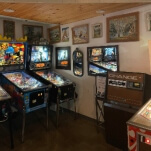The narrative of Rise Of The Tomb Raider practically writes itself. Not literally—that’s what returning Tomb Raider writer Rhianna Pratchett is for—but the story beats smack of reheated Hollywood blockbuster, like someone read the script for 2003’s by-the-numbers Lara Croft Tomb Raider: The Cradle Of Life and reworked it into a more believable scenario for the young woman from the reboot. Anyone with a general understanding of how most contemporary action-adventure plots (especially the aforementioned film’s) unfold will have no difficulty predicting, almost from the start, what’s going to happen. Lara Croft may be at the top of her game with a climbing ax, but she’s apparently not up on screenwriting 101, or how much the trajectory of her adventure resembles it.
The new game leans into its conventions, both in manner of play and story structure, but happily, the resulting adventure makes for a crackerjack entry in rousing puzzle-platformer fun. Rather than mucking about with much innovation, the developers have wisely played to the strengths of the Tomb Raider structure, crafting a fleet and enjoyable journey which may not set the world aflame with originality, but which executes its simple pleasures elegantly and with minimal fuss. It’s the game equivalent of a mass-market paperback from the airport bookstore: You know exactly what you’re getting, but when it’s done well, it’s immensely satisfying.
Picking up a year after the events of the previous game, which rescued the series from its moribund shame spiral, Lara Croft is now a more confident young woman, even as the game pivots around a new single-minded goal: the need to rescue her father’s good name from public ignominy by locating the lost city of Kitezh, which supposedly houses a treasure possessing the key to everlasting life. Flashbacks throughout the game show us Lara’s life with her father, as his fascination slowly curdled into an obsession that led to his debasement and death. Hoping to pick up where he left off, Lara travels—first to Syria, then Siberia—on a mission to secure the secret of immortality and share it with the world. Though, as you may already have guessed, her mindset slowly shifts over the course of the game.
Her antagonist this time around is Trinity, the shadowy organization looking to seize the source of immortality for themselves and use it to create an unstoppable army to conquer the world. Not exactly the first thing you’d assume someone would want to do with eternal life—making deals with friends about whether you can have their record collection when they die seems like a smarter initial move—but still, it sets up a race-against-time scenario that, in combination with the score, adds the requisite sense of urgency to your objectives.
That doesn’t mean you can’t take a breather every 20 minutes or so, at one of the numerous fire pits that double as checkpoints, where you can upgrade skills, weapons, and inventory. (Sometimes these are almost comically placed—at one point Lara is thrown into a new location with enemies mere steps away, an entire edifice shaking under her feet, when suddenly you can warm yourself by a cozy fire, should you so choose.) Much as in the earlier game, you acquire experience as you progress, unlocking new skill sets and and abilities, while the actual weapons and tools are acquired through various missions. One of the downsides to the free-range nature of many non-essential missions is that Lara is periodically running into obstacles requiring a tool she doesn’t have. This wouldn’t be frustrating, were it not for the fact that some of these aren’t acquired until much later in the main story, and in locations where you have no opportunity to return to the prior challenge—not without continuing forward in the mission, and often to an extensive degree.
But to dwell on these smaller annoyances is to miss the plethora of pleasures in Rise Of The Tomb Raider. As with the last outing, it borrows liberally from Uncharted, generally for the better. Yet while there’s plenty of gunplay and no shortage of ways to kill the endless parade of goons blocking your path (young Lara has obviously gotten over the whole “not wanting to kill people” thing), the real joy of the game stems from the fun of exploration. Maps are continually being upgraded to reveal ever new treasures and tombs, with coin caches and hidden treasures alike to tempt the hardy adventurer. You’re encouraged to seek out the optional secret entrances, and chart the caves to discover new challenges.
The side missions might constitute the most rewarding and delightful aspect of the entire project. Early on, as Lara makes her way through some slippery caverns in the ice, the player is invited to try and figure out how to acquire a relic from an old galleon sunken into the ice. This scenario has been lovingly constructed, with puzzles, beautiful imagery, and a precipice-dangling sense of danger. It gives the sense that the people behind this outing also felt the most joie de vivre in these small side adventures, where the gung-ho, swashbuckling spirit of Lara Croft can really shine.
Speaking of which, some of the complaints over the earlier installment appear to have been addressed. The puzzles, which were criticized in the initial reboot for being too quick to have Lara chime in with some overly enabling clue which ruined the fun, are solid and thoughtful. Most of them leave you to your devices, or merely have Lara offer up a, “Hmmm, I’ll need something else,” or other vague “getting colder”-type interjections. It’s not to say the game doesn’t sometimes step in a little too readily to help you out; there are still the odd moments where an enticing-looking obstacle is quickly resolved, thanks to the game not thinking you’re smart enough to figure it out yourself. But mostly, these have receded, unless it senses you’re having some real difficulty.
Even the set pieces have been improved. Seat-of-the-pants escapes are smoothly integrated into the game, so that, rather than merely holding a joystick forward as a snow peak collapses around you, you’re still expected to duck, jump, and wield your tools as you flee the scene. And only rarely does a quick time event show itself, usually when Lara doesn’t quite land a jump, or a wall of wood or ice begins falling apart. The firefights can sometimes feel frustrating or perfunctory, as though the game felt the need to go through the motions of including a high enough body count to satisfy those looking for a shooter outlet. But mostly, it’s an exhilarating treat.
Rise Of The Tomb Raider understands what’s fun about being Lara Croft. It’s not blowing away an army of underlings with an assortment of guns, something that straight-up shooters do better and with more commitment to variety. It’s also not some bold new innovation in how to make a character run and jump, or unexpected deviation from a storyline. No, what’s always been the key to Tomb Raider is the thrill of discovery. It’s about uncovering surprising ways to use your environment, to solve puzzles and mysteries in order to access temples and tombs. It’s the thrill of a smart and resourceful woman using every tool at her disposal to succeed where everyone else fails. There’s nothing new about this—the template of the intrepid explorer has remained incredibly consistent, from the novels of Jules Verne to radio serials to Indiana Jones—there’s merely the simple pleasures of a fast-paced adventure yarn, and Rise Of The Tomb Raider makes a strong case for why the fundamentals of a good game, well made, are their own reward.







































